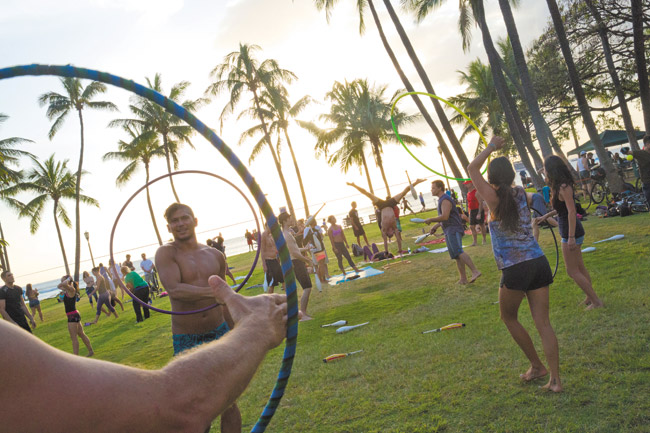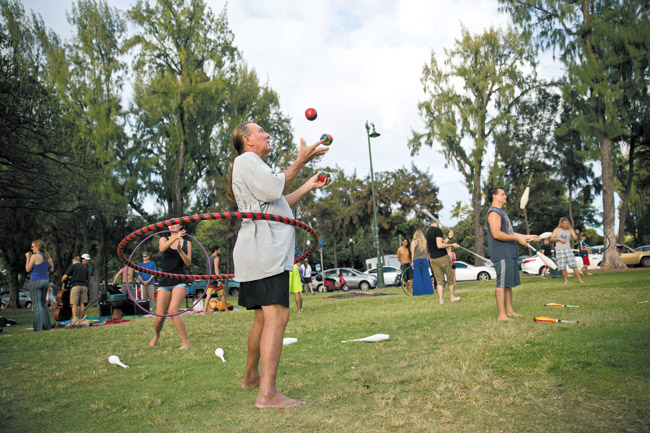Circus Jam In The Park
As the sun starts to set Sundays in Waikiki, an eclectic group of performers gathers to do all manner of circusy activities. it’s really ‘exercise in disguise’
On Sunday evenings as the sun goes down, you will find a strange migration taking place in Waikiki. Dressed in tank tops, tights, board shorts and loose, flowing pants and skirts, people of all ages descend on the 12 coconut palms near Queen’s Beach.
mw-riv-041515-sunday-circus-jam-2
What these individuals have come to do is truly unique. Just take a look at what they are carrying: a portable circus of hula hoops, juggling pins, staffs with flammable ends, yoga mats and other oddities — small crystal balls, poi balls and levitation sticks.
Bathed in the golden-hour light, bodies and props are cast in an explosion of movement. Powerful arms hoist sleek bodies above heads. Nimble fingers close around the napes of gyrating juggling pins. Bare feet step in rhythm to the throb of music.
Welcome to Cirque Waikiki, or circus jam, depending on who you ask. Once a place for acrobats to practice their skills, the lively weekly happening has coalesced into a haven for all manners of agility and balance, running the gamut from acroyoga, the more elaborate version of the flying you did as a child held suspended in the air on the feet of a friend, to slack-lining, much like tightrope walking.
“I wouldn’t say ‘circus practice’ because most of these people are not targeting going into the circus, but in terms of performance, all these people are into performing,” says veteran acrobat Dick Criley, an older yet youthful figure with perfectly defined musculature and aligned posture.
“I kind of coach, but I’m not full on ‘the’ coach,” Criley quips. Clearly modest, Criley has been on the scene since the early ’70s. Back then, under the direction of University of Hawaii physical education professor Don Gustuson, this weekly meeting started off on a somewhat different foot.
“Don had a group of us young people at the time trying to learn skills for tandem surfing. He was one of the early coaches for tandem surfing in Hawaii off Waikiki. Well, we learned a lot of the lifts and skills, but then we didn’t take them out on the ocean,” Criley says with a chuckle. “So we stayed on dry land in the sand.”
Over the years, and after changing locations to the grassy area in the mid-1970s, Criley was joined by another UH teacher, Don Hefner, and his brother Mike. These three are the founding members of the present-day Waikiki Acrobatic Troupe, which eventually became involved with the U.S. Sports Acrobatics Federation, competing and even hosting international championships in Hawaii.
“We’ve done more than 800 shows as a troupe over these 40 years,” Criley says.
Among the acrobats practicing handstands on top of partners’ outstretched arms there is a group of hula hoopers getting into their groove. Hoop dance instructors Kate McClain and Sirkka Aho call themselves Twirling Girlish, a nod to the whirling dervishes whose spinning dance is a form of religious mediation. Like the dervishes, their graceful dance with hula hoops helps them reach inner peace.
This is a far cry from the hula hooping you did as a kid. The hoops they use are larger, made from high-performance polymers, covered in colorful glittery tape and sometimes lined inside with LED lights that form kaleidoscopic comet trails when the sun goes down.
The women seamlessly move the hoops around their bodies. Lifting them off their waists to spin them overhead. Carrying them down to their knees. Jumping out of them without losing a beat.
“It’s exercise in disguise,” says McClain.
“It’s very joyful and meditative as well,” Aho adds.
Another hula hooper, Alli Vincent, similarly finds the experience therapeutic. “(It’s) escape in a really healthy, active way,” she says.
The friendship and sense of community that comes with hula hooping is also a draw for the trio. After joining the group three years ago, they use the Sunday sessions as an informal way to introduce their sport to newbies.
And it’s working. “The community has grown so much. It has been like watching your baby grow,” says Vincent.
Another aptly named duo are jugglers Billy Bellew and Andrew Towl of Kinetic Flow. They too have been a part of circus jam for three years, after a fortuitous meeting outside the zoo. “Andrew was eating at Lulu’s right across the street, and he saw me juggling so he came over and said, ‘Hey, I’m a juggler, too,'” says Bellew.
Though they practice on their own each week between private and public gigs, Sunday is their day to have fun and explore other art forms.
“We used to be pretty much just jugglers,” Bellew says, “and now we do juggling, we do whips, we do acrobatics, crystal ball stuff and other manipulation, and a little bit of magic.”
“There’s something about the technical aspect of (juggling) … being able to make an object do something that you wouldn’t expect it to do is really intriguing,” explains Towl.
In one of their signature feats, Bellew stands on Towl’s head — on one foot, no less — as they pass juggling pins up and down between them.
Criley says as long as young people are interested in learning these various practices, there’s no end in sight for this extraordinary weekly occurrence. He walks around helping others with handstands, watching for moments he can step in to offer suggestions to improve skills.
“Let me tell you that I’m 74 years old, and people tell me I don’t look it. That’s why I keep doing it!” he says with a hearty laugh.







